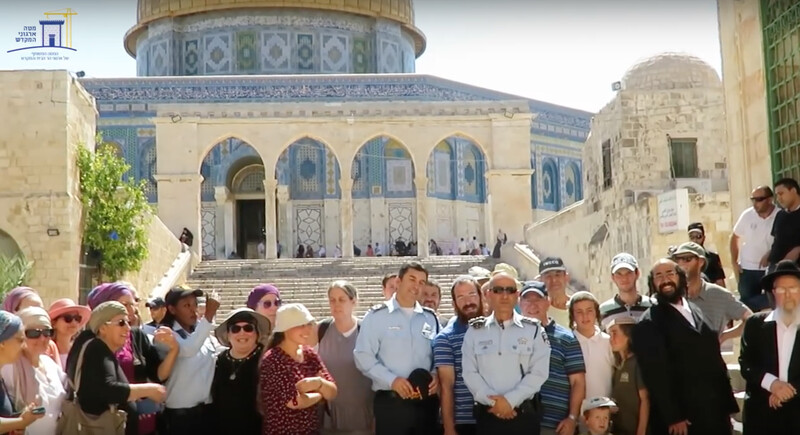Rights and Accountability 19 February 2018

Jerusalem district police commander Yoram Halevy, seen in uniform at center, poses with Temple activists in front of the Dome of the Rock. (Screenshot)
President Donald Trump’s declaration that the US would move its Israel embassy from Tel Aviv to Jerusalem was met with global condemnation and warnings that it could lead to a violent escalation.
But another threat to Jerusalem’s status quo, though no less dangerous, has received little international attention by comparison: Right-wing Israeli activists gained significant ground in their goal to take over the al-Aqsa mosque compound in the last year.
The so-called Temple movement, which has backers in Israel’s parliament and religious establishment, seeks to increase the number of Jews visiting the al-Aqsa mosque compound, one of the holiest sites for Muslims.
Swelling numbers of Jewish visitors, the movement believes, will force the hand of the Israeli government to grant permission to Jews to pray there.
That would pave the way for the holy site, referred to as Temple Mount by Jews, to be divided between Jews and Muslims. That has been the reality at the Ibrahimi mosque in Hebron, also in the occupied West Bank, ever since an American Jewish settler massacred 29 Palestinian worshippers there in 1994.
Temple movement activists ultimately seek the destruction of the Dome of the Rock, also housed in the mosque compound, and the construction of a Jewish temple in its place.
Police cooperation
This final scenario may currently seem unrealistic, “but in recent months we have clearly witnessed that the police are progressively acting in tandem with those advancing precisely this goal,” warns Ir Amim, a nonprofit group which envisions Jerusalem as a capital shared by sovereign Israeli and Palestinian states.
Where Israeli police once proved a barrier to Temple movement efforts, these activists now find cooperation and encouragement.
More than 22,000 visits by Jews to the al-Aqsa mosque compound were recorded in late 2016 and the first three quarters of 2017, an increase of almost 60 percent from the 14,000 visits made one year prior.
An Israeli attorney “who has filed numerous petitions on behalf of Temple activists,” according to Ir Amim, recently stated that “Netanyahu will have to approve prayer for Jews on the Temple Mount when their number of ascents surpasses 100,000 a year. This means no more than 300 Jews on average each day.”
According to Ir Amim, many Jews visit the mosque compound “motivated by the idea that their visits signify participation in the ongoing campaign to alter the status quo.”
The group has observed “a radical shift between police officers and Temple movement activists.”
Police officers were once “careful not to demonstrate personal bias favoring political activists with whom they come into contact in the line of service.” But in recent months, Ir Amim states, officers “have frequently been photographed with members of the Temple movement in public displays of affection.”
The Jerusalem police district commander Yoram Halevy has been recorded on video embracing Temple mount activists and receiving a ritual blessing from an activist at an entrance to the compound.

Yoram Halevy receives a blessing from a Temple activist in front of the Dome of the Rock. (Screenshot)
Halevy threatened injuries and fatalities against Muslim worshippers after mass demonstrations were held in the streets of Jerusalem over new police restrictions at al-Aqsa mosque last July.
Five Palestinians were killed amid a crackdown on Jerusalem protests that month and three members of an Israeli family were fatally stabbed by a Palestinian assailant in a West Bank settlement.
Open door
Ir Amim also notes that Temple activists were distinguished guests at a farewell party near an entrance to the al-Aqsa mosque compound for a police commander upon the conclusion of his post at the site.
They were also “officially invited to the ceremony marking transfer of responsibilities” when the commander of the precinct encompassing the holy site completed his appointment.
“The outgoing commander went so far as to acknowledge them in his farewell speech,” according to Ir Amim.
Imagery of cooperation and affection between Temple movement activists and the police “serves to stoke the motivation of [Temple movement] supporters,” Ir Amim states.
Police have meanwhile looked the other way when Temple activists have violated a prohibition against Jewish worship at the al-Aqsa mosque compound or worn provocative T-shirts advocating the destruction of the Dome of the Rock.
Temple movement signage now hangs at the entrance to the Mughrabi bridge – the entry-point for non-Muslim visitors to the holy site after crossing a police checkpoint – as if the right-wing activists “had been granted official public status over the area.”
Police have allowed activists to hold religious classes at Mughrabi Gate, treated by the activists as an ad hoc yeshiva to train an army of worshippers once Jewish prayer at al-Aqsa is permitted.
Ir Amim points to Gilad Erdan – Israel’s strategic affairs minister who oversees a “black ops” program to combat the nonviolent boycott, divestment and sanctions movement (BDS) in support of Palestinian rights – as “the root of this provocative change in police conduct.” Erdan also holds the “internal security” portfolio in the Israeli government.
“During Erdan’s tenure, new officers have been appointed to sensitive positions relating to the Temple Mount,” according to Ir Amim.
“Temple activists report that the minister’s door is open to their representatives and that he is attentive to their concerns.”
Ir Amim notes that the Islamic Waqf endowment that administers the al-Aqsa mosque compound has responded to these changes to the status quo with caution.
“The combination of Minister Erdan’s desire to strengthen the Temple movements and the police perceiving that erosion of the status quo does not meet with strong Muslim protest may encourage the Israeli authorities to take more hazardous steps,” Ir Amim warns.
Such an erosion could lead to an escalation of violence, the group adds, “as it did in the summers of 2014 and 2015 when the cost of attempts to infringe upon Muslims’ freedom of worship … was bloodshed in Jerusalem.”
More than 250 Palestinians and 35 Israelis were killed in a year-long wave of protest and violence following unchecked Israeli assaults and incursions on the al-Aqsa mosque compound in September 2015.
Israeli forces have slain several more Palestinians, including children, during protests against Trump’s Jerusalem declaration.
Brutal beating
The brutal force used by police against Palestinians protesting Israeli designs on Jerusalem is starkly contrasted by their leniency towards Jewish mobs who rampage through its Old City.
On Wednesday, Mustafa al-Mughrabi, a Palestinian resident of the Old City, was severely injured by a crowd of Israelis while they were exiting the al-Aqsa mosque compound.
Police “called the incident a fight,” the Israeli daily Haaretz reported.
Honenu, a legal aid organization that represents Israelis accused of harming Palestinians, claims that a group of Jews “were attacked by a number of Arab assailants and were forced to defend themselves.”
One of the group of Israelis was reportedly severely injured in his face.
Video shows a bloodied al-Mughrabi lying on the ground, his body convulsing:
Al-Mughrabi told the Ma’an News Agency that he was beaten after Israelis leaving al-Aqsa approached a group of his friends who were standing near the exit, and al-Mughrabi went up to them to see what was the matter.He lost consciousness during the attack.
Video shows police escorting a large number of right-wing Israelis at the al-Aqsa compound earlier that day:
The evening before al-Mughrabi was attacked, construction began on a new major settlement project a short distance away from the al-Aqsa mosque compound.The Palestinian Center for Human Rights stated that the building of the three-story religious study center falls under Israel’s “policy to make a Jewish majority in the city and change its character.”





